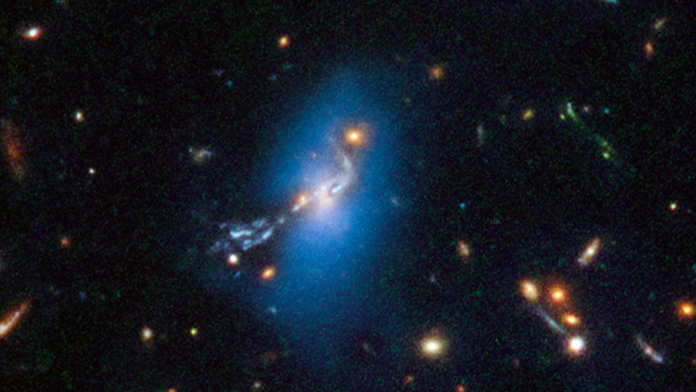Stars are typically very “social” things. Thanks to gravity, they’re often found bound together in full-blown galaxies like our own Milky Way or much smaller star clusters.
But spread throughout the universe are rogue stars that remain gravitationally untethered to others, wandering endlessly in the vastness of space. Although the light from these stars, which is known as intracluster light, was first discovered in 1951 by Fritz Zwicky, a new infrared survey by the Hubble Space Telescope has shed light, if you’ll excuse the pun, on that faint glow — and the research might help scientists solve the mystery of the origin of these wayward stars.
The survey studied 10 galactic clusters, or gravitationally bound groups of galaxies, at distances as far as 10 billion light-years away. What researchers discovered in the data was that the ratio of intracluster light compared to the total light of the clusters is constant. That suggests that the wandering stars are old — billions of years old — and not likely recently ejected from established galactic clusters through stripping (when massive gravitational tides pull material out of galaxies). If stripping were the main origin of wayward stars, scientists would expect to see the fraction of intracluster light increase over time compared to the light of galactic clusters.
Related: The best Hubble Space Telescope images of all time!
“We don’t exactly know what made them homeless. Current theories cannot explain our results, but somehow they were produced in large quantities in the early universe,” James Jee, an astronomer at Yonsei University in South Korea and co-author on the new research, said in a statement. “In their early formative years, galaxies might have been pretty small and they bled stars pretty easily because of a weaker gravitational grasp.”
While Hubble will continue to survey the universe looking for intracluster light, the James Webb Space Telescope is also getting in on the fun. Together, the powerful observatories will hopefully aid scientists in unraveling the mystery of how wandering stars are born.
And perhaps a larger mystery as well, since these strange stars may give scientists a glimpse of dark matter, the invisible material that makes up most of the matter in the universe and whose gravitational force holds galaxies together.
“If we figure out the origin of intracluster stars, it will help us understand the assembly history of an entire galaxy cluster, and they can serve as visible tracers of dark matter enveloping the cluster,” co-author Hyungjin Joo, also of Yonsei University, said in the same statement.
A paper on the team’s research was published on Wednesday (Jan. 4) in the journal Nature (opens in new tab).
Follow Stefanie Waldek on Twitter @StefanieWaldek. Follow us on Twitter @Spacedotcom and on Facebook.

